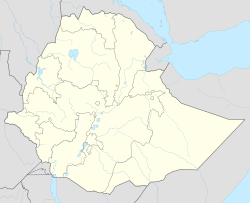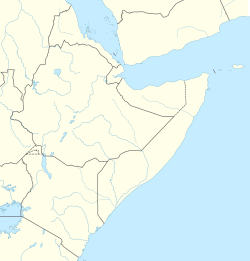Hawassa facts for kids
Quick facts for kids
Hawassa
አዋሳ
Awassa
Awasa |
|
|---|---|
|
From top: Sidama Monument; Hawassa Industrial Park; Hawassa Kenema Stadium; St. Gabriel Church; Outskirt view; Lake Hawassa
|
|
| Country | Ethiopia |
| Region | |
| Founded | 1958 |
| Founded by | Haile Selassie |
| Area | |
| • Total | 50 km2 (20 sq mi) |
| Elevation | 1,708 m (5,604 ft) |
| Population
(2007)
|
|
| • Total | 258,808 |
| • Estimate
(2023)
|
577,075 |
| • Density | 5,200/km2 (13,400/sq mi) |
| Time zone | UTC+3 (EAT) |
| Area code(s) | 46 |
| Climate | Aw |
Hawassa (Amharic: አዋሳ), also known as Awassa or Awasa, is a city in Ethiopia. It sits right by Lake Hawassa in the amazing Great Rift Valley. Historically, it was called Adare.
This city is about 273 km (170 mi) south of Addis Ababa, Ethiopia's capital. It's also 130 km (81 mi) east of Sodo and 75 km (47 mi) north of Dilla. Hawassa is the capital city of the Sidama Region. It's located on a very important road called the Trans-African Highway 4, which connects Cairo all the way to Cape Town.
Hawassa is about 1,708 meters (5,604 ft) above sea level. Its name comes from a Sidamic word that means "wide body of water," which makes sense because of the big lake nearby!
The city is home to Hawassa University, a large university with different colleges. There's also Awasa Adventist College and a busy market. Hawassa has its own airport, Awasa Airport, which opened in 1988. You can also find postal, electricity, and telephone services here. Two cool places to visit are the St. Gabriel Church and the Awassa Kenema Stadium. Fishing is a big business for the people living here.
Hawassa used to be the capital of the old Sidamo Province until 1995. Then, it became the capital of the Southern Nations, Nationalities, and Peoples' Region. In June 2020, when the Sidama Region was created, Hawassa became part of it. Currently, Hawassa is the capital for both the Sidama Region and the Southern Nations, Nationalities, and Peoples' Region. The government of the Southern Nations, Nationalities, and Peoples' Region will eventually move to another city within its own borders.
Contents
Hawassa's History
In 1957, Emperor Haile Selassie wanted to build a new town where Hawassa is now. The area was perfect because it was on a main highway. It also had flat land for building and beautiful places like Lake Hawassa and Dume hill (now called Tabor).
How Hawassa Started
In 1958, the emperor had a seasonal palace built by Lake Awasa. This made more people interested in the area. As the town grew, many people who lived there had to move. About three thousand people were displaced from their homes.
Some people, like Governor Ras Andargachew Mesay, were worried about the people who had to move. Their houses were sometimes bulldozed without warning. Even with these concerns, the government continued with its plans to build the city.
New Residents and City Growth
After the original residents moved, about 400 families were given land in Hawassa. These families had served in the war against Italy from 1935–1941. They came from different parts of Ethiopia, like Wukro, Korem, Harar, and Addis Ababa. The areas where they settled still have names from their original homes.
In 1960, a local government office moved to Hawassa. A city government was officially started in 1962. Moving the capital to Hawassa wasn't easy. Landlords in Yirgalem didn't want the capital to move from their city. Before Hawassa, the capital had been in Hagereselam and then Yirgalem.
Finally, in 1968, Hawassa officially became the capital of the Sidamo Governorate General. This area included many different groups like Sidama, Wolayta, and Gedeo. Later, in 1974, it became the capital of the Sidamo district under a new government. It then became the capital of the Southern Nations, Nationalities, and Peoples' Region and later the Sidama Region.
Hawassa is growing fast. It has eight smaller areas called sub-cities, which include both city and rural parts. These sub-cities are named Addis Ketema, Hayk Dar, Bahil Adarash, Misrak, Menahreya, Tabor, Mehal Ketema, and Tula.
Hawassa's Population
Who Lives in Hawassa?
According to a 2007 study, Hawassa had a total population of 258,808 people. About 133,123 were male and 125,685 were female. Most people, about 61%, lived in the main city of Hawassa. The rest lived in the nearby rural areas. There were 61,279 households, with about 4.22 people living in each home.
The largest groups of people living in Hawassa are the Sidama (48.68%), Amhara (15.43%), and Welayta (13.90%). Other groups include Oromo (5.21%) and Gurage (4.33%). Many other smaller groups make up the rest of the population.
Languages Spoken
The main language spoken in Hawassa is Sidamo, by about 47.97% of the people. Other common languages include Amharic (31.01%), Welayta (9.58%), Oromiffa (2.53%), Gurage (1.98%), and Kambatta (1.82%).
Hawassa's Economy
The Hawassa Industrial Park (HIP) is a special factory area outside the city. It was built to be environmentally friendly. It opened on July 13, 2016, and was started by Prime Minister Hailemariam Desalegn.
Industrial Park and Jobs
The park focuses on making clothes and fabrics. It started with an area of 130 hectares and can grow to 400 hectares. It has a special system that cleans water so no dirty water is released. This helps companies meet strict environmental rules for selling products internationally.
At its busiest, the Hawassa Industrial Park employed over 35,000 workers. In 2022, some factories closed, and jobs were lost. This happened after the United States removed Ethiopia from a trade agreement. However, things started to get better between October 2022 and January 2023. The park made 32 million USD, showing that the industry might be recovering after a peace agreement.
Religion in Hawassa
In Hawassa, many different religions are practiced. About 52.71% of the people are Protestants. Around 39.99% follow Ethiopian Orthodox Christianity. About 7.30% are Muslim, and 3.78% are Catholics.
The Catholic community is served by the Apostolic Vicariate of Awasa. This is a special church area that has its main church, called a Cathedral, in Hawassa.
Sports in Hawassa
Football (soccer) and swimming are the most popular sports in Hawassa. The city has its own football club called Hawassa City S.C.. This team, along with others like Debub Police S.C. and Sidama Coffee S.C., plays at the Awassa Kenema Stadium. Hawassa City S.C. was the first team from outside Addis Ababa to win the Ethiopian Premier League. They have won the league twice and played in the CAF Champions League two times.
Other sports are also becoming popular with young people. These include basketball, with a team called Hawassa City BC, and skateboarding. Sometimes, biking and running races are held on the main streets of the town.
Education in Hawassa
Hawassa University is a big university in the city. It was created in 1999 by combining several other schools. Info link College is the first private engineering college in Hawassa. The Africa Beza College also has a campus here. Hawassa University was the first university in Ethiopia to offer a degree program in Hotel Management.
Hawassa's Climate
Hawassa has a tropical savanna climate, which means it's generally warm all year. It's also close to a subtropical highland climate. There are two main seasons:
- A long wet season from March to October, which isn't too intense.
- A short dry season from November to February.
Even though the sun is higher in the wet season, it's actually cooler because there are more clouds. The coldest mornings, sometimes near freezing, happen during the dry season.
| Climate data for Hawassa | |||||||||||||
|---|---|---|---|---|---|---|---|---|---|---|---|---|---|
| Month | Jan | Feb | Mar | Apr | May | Jun | Jul | Aug | Sep | Oct | Nov | Dec | Year |
| Record high °C (°F) | 32.6 (90.7) |
33.0 (91.4) |
33.5 (92.3) |
33.6 (92.5) |
31.4 (88.5) |
30.2 (86.4) |
28.8 (83.8) |
29.2 (84.6) |
29.2 (84.6) |
30.5 (86.9) |
31.6 (88.9) |
31.3 (88.3) |
33.6 (92.5) |
| Mean daily maximum °C (°F) | 28.4 (83.1) |
29.2 (84.6) |
29.3 (84.7) |
27.9 (82.2) |
26.6 (79.9) |
25.2 (77.4) |
23.6 (74.5) |
24.1 (75.4) |
25.0 (77.0) |
26.2 (79.2) |
27.5 (81.5) |
27.9 (82.2) |
26.7 (80.1) |
| Mean daily minimum °C (°F) | 10.4 (50.7) |
11.6 (52.9) |
12.5 (54.5) |
13.6 (56.5) |
13.8 (56.8) |
13.9 (57.0) |
14.0 (57.2) |
13.9 (57.0) |
13.1 (55.6) |
11.8 (53.2) |
9.4 (48.9) |
9.2 (48.6) |
12.3 (54.1) |
| Record low °C (°F) | 0.8 (33.4) |
3.0 (37.4) |
5.1 (41.2) |
6.5 (43.7) |
9.0 (48.2) |
8.5 (47.3) |
7.7 (45.9) |
7.2 (45.0) |
7.5 (45.5) |
3.5 (38.3) |
0.5 (32.9) |
−2.8 (27.0) |
−2.8 (27.0) |
| Average rainfall mm (inches) | 29 (1.1) |
44 (1.7) |
100 (3.9) |
147 (5.8) |
133 (5.2) |
99 (3.9) |
128 (5.0) |
125 (4.9) |
140 (5.5) |
92 (3.6) |
30 (1.2) |
24 (0.9) |
1,091 (42.7) |
| Average rainy days (≥ 0.1 mm) | 5 | 8 | 16 | 16 | 16 | 15 | 19 | 20 | 22 | 14 | 5 | 4 | 160 |
| Average relative humidity (%) (daily average) | 47 | 45 | 47 | 63 | 68 | 68 | 70 | 71 | 73 | 64 | 54 | 49 | 60 |
| Average dew point °C (°F) | 10 (50) |
10 (50) |
11 (52) |
14 (57) |
15 (59) |
15 (59) |
14 (57) |
15 (59) |
15 (59) |
14 (57) |
12 (54) |
10 (50) |
13 (55) |
| Source 1: National Meteorology Agency (average high and low, extremes) | |||||||||||||
| Source 2: World Meteorological Organization (rainfall 1981–2010) Time and Date (dewpoints and humidity, 2005–2015) | |||||||||||||
See also
 In Spanish: Hawassa para niños
In Spanish: Hawassa para niños












